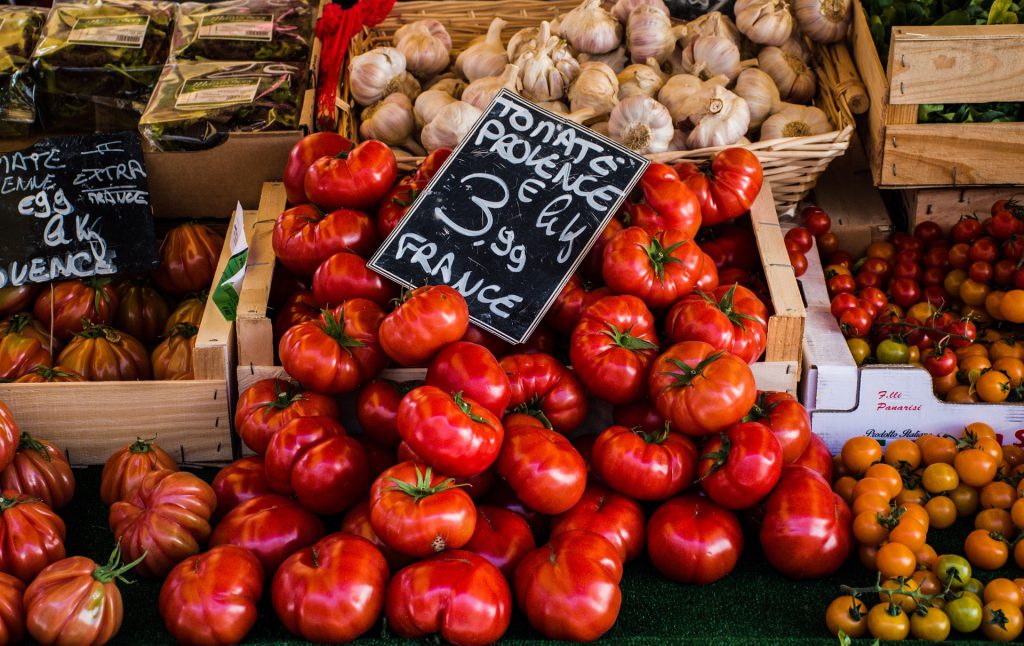When we think of fancy foods, French food usually comes to mind. French cuisine and cooking techniques have dominated the cooking scene world-wide, but have they rightfully earned this position? French chefs strive for perfection in every aspect of their cooking, most of which shines through their style of food presentation. They highly value presentation and have effectively used it to attract customers and to sell their foods for decades. Can the French keep their seat at the head of the table entirely based on how good people say their food is? If you were to have a spontaneous survey asking people whether French food is good or not, you would probably get mixed responses. A few might complain that French food is overrated and others might praise the French for their innovative approaches to cooking. Even though we might land on different sides of the question, many of us can agree to having had pleasantly delicious French dishes. Buttery, flaky croissants, soupe à l’oignon (French onion soup), fragrant baguettes, or a plate of ratatouille are easily favorites across the board. When we think of these dishes, the pictures in our minds probably are not that fancy, unless you’re thinking of a plate of confit byaldi being prepared by a rat in movie. Although these traditional French dishes don’t necessarily seem too fancy and elaborate to us, they have earned their rightful places at our tables purely for their deliciousness and rich quality. However, some French restaurants have begun to slip from their usual high standards of perfection in French cooking. The focus has shifted from producing both high quality food and high quality presentation to high quality presentation with often lower quality foods.

But what exactly does quality mean in French cuisine? For the French, quality means technique. The French have introduced long-standing techniques such as flambéing, braising, poaching, and sautéing. These techniques have become the standard for kitchens across the globe and are used daily in restaurants to prepare a variety of dishes, many of which are not even of French origin. Just think of all the delicious soups that get all their flavor from using the technique of sautéing to highlight the wonderful flavors of the base ingredients! In French cooking, quality also means fresh ingredients. Choosing good ingredients is the first and most important step to making good food. French cuisine has heavily relied on the freshest ingredients gathered from local farms to create dishes with the highest of quality. Their cheese, butter, and milk largely comes from grass-fed, hormone-free cows making their dairy some of the healthiest to consume. Open air markets provide chefs with choice garden-fresh fruits and vegetables to create dishes boasting the most spectacularly bright flavors.1
Of course, with the popularization and high demand of French food, the sole use of straight-from-the-farm ingredients has to be slightly compromised in order to meet customer demand.2 This does not mean quality should be an afterthought, but it is undeniable that there are some French restaurants and bakeries that will hide their sub-par work behind the pre-established reputation of a dish and much too high prices. It’s no secret that it is getting harder to find authentic and satisfactory French food. As of 2019, France has become the largest European market for McDonald’s, which has invited many other fast food options to saturate the French restaurant scene.3 Because of the fast-food culture that dominates the food world, many French-based bakeries are struggling to produce food that lives up to the high standards of traditional French cuisine. Several bad French eateries have gotten good at masking poor food behind presentation, leaving their customers feeling cheated because of how overpriced and disappointing the food is.4 This would lead some to say that the French have completely thrown good food out the window, having put more effort into food presentation rather than focusing on the quality of their food. However, bad restaurants that cut corners shouldn’t cloud the fact that a majority of the French really do strive for perfection in their cooking and food presentation.

A study done by students at Monte Clair University and the Culinary Institute of America explained that a meal and the foods comprising that meal are liked better if they are plated in an attractive way than if they are plated in an equally neat, but less attractive manner.5 High-end French restaurants are fully aware of this fact and know how to use presentation to its fullest potential. Knowing their customers would be more inclined to purchase and eat a dish that is beautifully presented, they spend time carefully plating their foods. This is known in French cooking as haute cuisine, a type of cooking that focuses on the preparation of high-quality ingredients to create high-quality food all while following the style of traditional French cuisine. This is where Marie-Antoine Carême, the creator of haute cuisine and pioneer in the creation of presentation in French cuisine, enters the scene. He greatly influenced not only the basics of French food, but also stressed the importance of food presentation. For French baking in the 1800s, pastries were made mainly for the wealthy, making it completely understandable that presentation and freshness was vital in the sales made. However, in his teens, Carême was inspired to take presentation to an entirely new level. He knew very early in his career, that before we even taste food we judge its appearance; so he made every effort to master his food presentation.6

Carême spent long hours in the library studying architecture and spent the remainder of his time in the kitchen, applying what he learned to arrange magnificent architecture-like creations made of pastries and sugar.7 He was known for well documenting his journey in the kitchen, having written many cookbooks in his lifetime. He encouraged people to try his techniques for themselves at home. His invention of haute cuisine was one of his many great accomplishments. Haute cuisine permanently impacted French cooking and presentation, and has lived on in our modern kitchens, encouraging chefs to push the boundaries in presentation.
In addition to being a trailblazer, Carême was also awarded opportunities to cook for lords, princes, and ambassadors from all across Europe, some of the most notable royalty being Emperor Alexander I of Russia and Russian Princess, Catherine Bagration. His work for these notable individuals awarded him the status of “first celebrity chef.”8 Because of French cuisine’s association with high class, Paul Freedman, a professor at Yale University, believes French cuisine’s association with snobbery has only contributed to its demise.9 The French obviously have extremely high food standards, but this doesn’t make their food snobby. However, some might turn their noses up at French food because of the snobbery it is associated with. Henri Soulé, the owner of the famous Le Pavillon and La Côte Basque restaurants in New York City, had a part in creating a culture of snobbery. The food he made was nothing short of incredible even having critics labeling his food as “fit for the gods.” However, with the elaborate foods regularly made in his restaurants, Soulé began to miss the more ordinary foods of France. He began preparing simple French dishes and placed them as off-menu items only to be served to those he thought could truly appreciate real French cooking. His favor for certain customers began the trend of social discrimination and snobbery in many high-end French restaurants. However, the snobbish behavior of some French restaurants shouldn’t muddy our perception of their food or be a reason to assume it is on a rapid decline. Through their cooking and careful choice of ingredients, we can easily see the French strive for excellence not only in these areas, but also through flavor.
Some prefer spicy Indian foods, while others can’t get enough of tangy Mediterranean dishes. The French are those who gravitate toward simple flavors, most of which are derived from ingredients many of us have in our pantries. For example, Carême’s mother sauces of espagnole, veloute, bechamel, and hollandaise are based on stocks, flour, butter, eggs, and milk. Anyone can easily walk into their pantry and find every ingredient for a majority of these sauces! Of course, when the mother sauces are being discussed, Auguste Escoffier deserves to be mentioned. Roughly 100 years after Carême’s time, he updated the list of sauces with the addition of tomato.10 Considering how much flavor comes straight from their ingredients and the cooking techniques used to maximize those flavors, it is understandable that these sauces are mild and meant to be used as a building block in French cooking. But repetitive sauces and ingredient combinations might be why some will complain that French cuisine is overrated. The mother sauces are bland and flavors have become predictable. The French have clearly been set as the standard for high quality food and with this comes with the ability to brand themselves and give their customers the experience of belonging to a higher social class. When you go to a fancy French restaurant, you are not only paying for the food, but for the aesthetic quality and the security that the food will be up to their standards of quality. French food can be overrated compared to foods around the world similarly the way Apple’s iPhone can be seen as overrated compared to other smart phones. Yes, the quality of French food and Apple products alike is good, but we can all agree that a fancy plate and photo-worthy presentation isn’t essential to display the quality of French food, just like a phone without an Apple logo doesn’t make it any less modern or capable. This brand the French have created for themselves might be why many of us don’t think twice about what we are being served and can overlook things like low quality when we’re so focused on capturing the perfect photo for our social media. Presentation, although captivating, can distract us from the bigger picture, which is the quality of the food we’re eating. When presentation is subtracted from the recipe of French cooking, is it as good as people say it is?
This answer would simply boil down to personal flavor preferences. Regardless of preference, supportive or discouraging, French cuisine deserves to be recognized for what it is—a cuisine based on quality ingredients, prepared with state of the art techniques, all enhanced by eye-catching presentation. Lousy French restaurants using presentation to their advantage only to hide half-baked efforts should not be used as an example for what French cuisine is. French cuisine values the patience and care taken to gather and prepare quality ingredients to create exquisite food that has people flocking world-wide so they too can taste food fit for royalty.
- “Is French Cuisine Really The Best In The World?”, 2020, Lefoodist (website), https://www.lefoodist.com/guides/cooking-classes-paris/cookingparis90.html ↵
- Anna Brones, “French food: Not so fresh?” BBC Travel, April 3, 2014, http://www.bbc.com/travel/story/20140403-french-food-not-always-so-fresh ↵
- Sean Ross, “10 Countries with the Most McDonalds Locations,” Investopedia, March 2, 2020, https://www.investopedia.com/articles/markets-economy/091716/10-countries-most-mcdonalds-locations-mcd.asp ↵
- Alex Ledsome, “Is France’s Culinary Reputation in Decline?”Forbes (online), July 28, 2019, https://www.forbes.com/sites/alexledsom/2019/07/28/is-frances-culinary-reputation-in-decline/#789cc61d33ee ↵
- Debra A. Zellner, Christopher R. Loss, Jonathan Zearfoss, Sergio Remolina, “It tastes as good as it looks! The effect of food presentation on liking for the flavor of food,” Appetite, Vol. 77, (2014): 31-35. ↵
- Anisa Kazemi, “The Importance of Food Presentation,” Savvy Tokyo, June 23,2016, https://savvytokyo.com/food-presentation-time/ ↵
- Priscilla Parkhurst Ferguson, “Writing Out of the Kitchen: Carême and the Invention of French Cuisine,” Gastronomica 3, no. 3 (2003): 2. ↵
- Daniela Galarza, “A Name You Should Know: Marie-Antoine Careme,” Eater, June 3, 2016, https://www.eater.com/2016/6/3/11847788/careme-chef-biography-history ↵
- Paul Freedman, “People don’t like French food as much as they used to because French restaurants are pretentious,” Quartz, October 27, 2016, https://qz.com/816889/people-dont-like-french-food-as-much-as-they-used-to-because-french-restaurants-are-pretentious/. ↵
- Lindsey Nair, “An Intro to the Five Mother Sauces,”The Roanoke Times, Oct 21, 2009. ↵



11 comments
Fatima Esparza
It is sad that French cuisine has lost its authentic touch of quality to it. It seems that many restaurants and chefs worldwide focus more on their dishes’ presentation rather than the quality of their taste. Regardless, it is very interesting reading about the different techniques French cuisine uses, even if some only use them to attract people to like the food. Hopefully, more authentic French restaurants can get more recognition for using the techniques correctly.
Karla Fabian
This article was so interesting to me because I was unaware of this French food crisis. It was very concerning to read how French restaurants prefer to focus more on presentation than the quality of the food. This reflects how people are willing to pay exaggerated prices due to the presentation of the food instead of the quality of it. This article also shows how nowadays we focus more on looks than on quality. Like we see restaurants that have social media spend a lot of time editing their photos, which in the end do not look like the final product.
Aaron Sandoval
I found this article very interesting, rarely do we read articles on this site that covers food, and the author did a good job of covering such a unique topic.
I found it very interesting that French restaurants were having to focus on the presentation of their food rather than the quality, and raising prices on this food to stay afloat. This article was a very interesting read, and I found myself learning something new.
Emilia Caballero Carmona
Hey Janaya, I was so interested on reading your article because personally I had never heard about this French food crisis. I was in shock to read that some French restaurants are preferring to make high quality presentation with lower quality foods, than producing high quality food and high-quality presentation. I had always thought that French food was so unique because they produced both high quality food and high-quality presentation, so to read this is unfortunate because I think French restaurants doing this, takes away a lot from French cuisine in general.
Yousef Alghamdi
Very interesting and capitative article Janaya. It is fascinating to know that chefs are taking the step of favoring presentation over quality. I found the study by students at Monte Clair University and the Culinary Institute of America very interesting, I have never thought about the presentation of the dish That I am going to eat. Thank you for providing us with such information, I enjoyed reading your article.
Madeline Chandler
Such an informative and interesting article! Very captivating. Honestly I am unfamiliar with french cuisine yet it is so intriguing. Not many people write about food and this was such a different approach but I loved it. It is so sad that cheaper chains are diluting true french food.I hope that cultures can remain true to their cuisine. I loved reading your article. Great job.
Andrea Salas
This article is very interesting to read ! Writing about food was great way to go, just because it draws in a lot of different types of people, This is because food is an important factor in everyones life. French foods have always been so interesting to me. Not only are they taste good, but the aesthetic are good as well. Now I know why. Like you said, they strive for perfection in every single aspect of their food.
Camryn Blackmon
Hi Janaya,
I really enjoyed that you chose to write about food because I think it can be engaging for many people. It was interesting to learn more about french food itself because from my experience, and I have mainly had french pastries but not really soups or dishes so it was fun to learn the recipes and cooking methods globally that have been influenced by the French. I also liked how you described an issue and controversy based on the quality of it and also provided some important historical people and information on where these methods of cooking originated.
Sara Alvirde
I have been looking for more culinary articles because I love food! Who doesn’t!?! I have always had a spot in my heart for French cuisine and it also occurred to me that fast food is always overpowering over presentation in food. But what food that focuses on presentation forgets to add to the dish is the quality of food. Even now fast food has also been in the competition of presentation so their food becomes trendy on social media. This article and the bio of the person who made this article truly understands that learning the origins of food will bring us closer to enjoying true savory food.
Jourdan Carrera
I personally have seen this for a long time, the fact that mot people, including myself, are often tricked into paying absurd prices for something just because it looks nice is unfortunate. It is sad but also understandable that with more and more fast food restaurants arriving in France offering cheap and filling meals restaurants must be forced to adapt in any way they can or risk going under.